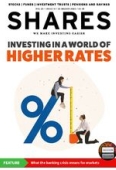Archived article
Please note that tax, investment, pension and ISA rules can change and the information and any views contained in this article may now be inaccurate.
Why the Credit Suisse bailout has failed to calm investors’ nerves

Another week, another bank failure, or so it seems these days.
News that ailing European lender Credit Suisse (CSGN:SWX) had been saved from insolvency over the weekend thanks to a take-over by its larger rival UBS (UBSN:SWX) should in theory have eased concerns of ‘contagion’ across the banking sector.
However, details of the rescue – and in particular the fact the regulator decided to mark the value of some of the bank’s debt down to zero – have sparked new fears among bond investors over the value of some financial instruments should other banks get into trouble.
BONDHOLDERS BURNED
In an unprecedented move, the Swiss banking regulator FINMA allowed shareholders to preserve some of their equity in Credit Suisse – albeit not a great deal – at the expense of holders of the bank’s Additional Tier One or AT1 bonds.
AT1s, also known as Contingent Convertibles or CoCos, are bonds issued by banks to boost the level of capital they hold to meet the requirements set by the regulator.
They typically carry a high rate of interest because the coupons are discretionary, so non-payment isn’t considered a default, and in the event a bank gets into trouble the bondholders are given shares instead.
‘AT1 bonds were introduced in Europe after the global financial crisis to serve as shock absorbers when banks start to fail’, explains Charles-Henry Monchau, chief investment officer at Syz Bank.
‘They are designed to impose permanent losses on bondholders or be converted into equity if a bank’s capital ratios fall below a level, effectively propping up its balance sheet and allowing it to stay in business.’
According to the Swiss bail-in regime, AT1 debt normally ranks above equity in the event of bankruptcy, so the decision to write it down to zero – while it is strictly legal – is ‘an arresting development’ says Monchau.
The prospectus for Credit Suisse’s 9.75% AT1 bonds stated that in the case of a ‘contingency event’ such as its Core Equity Tier One capital ratio falling below the required threshold, or a ‘viability event’ such as the bank becoming insolvent or unable to carry on its business, ‘the full principal amount of each Note will be written down to zero’ and ‘the holders will be deemed to have irrevocably waived their rights to repayment of the aggregate principal amount of the Notes’.
HAVEN’T WE BEEN HERE BEFORE?
If all of this sounds familiar, it was fancy financial engineering and an alphabet soup of ABS (asset-backed securities), CDOs (collateralized debt obligations), MBS (mortgage-backed securities) and other novel instruments which brought down the banks, insurers and hedge funds during the great financial crisis.
Ironically, AT1s were part of a ‘new regime’ called Basel III designed to improve both the quantity and quality of capital held across the European banking system after governments and taxpayers had to bail out a number of lenders.
To meet their minimum or ‘core’ equity capital, banks in the US were able to tap into the well-established preference-share market to top up their AT1 reserves, while European banks issued bonds instead.
Clearly, neither Credit Suisse, the regulator nor the bondholders ever envisaged a situation where their investment would be written off as, like so many other large lenders, Credit Suisse was considered ‘too big to fail’.
With the benefit of hindsight, bondholders are now either trying to sell out of their AT1 bonds – the market is estimated to be worth $275 billion around the globe – or having to mark down their value in their portfolios as prices tumble.
UNINTENDED CONSEQUENECS
One major knock-on effect of the failure of Credit Suisse and the crisis of confidence in US regional lenders after the collapse of Silicon Valley Bank earlier this month has been a sudden about-turn in market expectations for interest rates.
Whereas many observers had expected the US Federal Reserve to increase its benchmark rate by another 0.5% this week, followed by further rises in the summer to head off stubbornly high inflation, most now expect the central bank to move rates up by 0.25% at the most and possibly cut rates later in the year if the economy shows signs of going into recession.
This rapid shift in expectations and the sharp swing in short-term interest rates has triggered huge losses for investors who were betting the Fed would keep ratcheting up rates this year.
According to a recent Reuters report, ‘trend-following and macro funds, and CTAs (Commodity Trading Advisors), have been badly wrong-footed by the rates reversal, registering up to double-digit losses for the month by early last week’.
The report adds: ‘The damage to investors of all stripes from the recent level of volatility in short-end US interest rates and bond yields cannot be overstated, and those with direct exposure will be hit especially hard.’
It is worth adding that at one stage there were $20 trillion of bonds trading at negative interest rates, which assuming they were held ‘to maturity’ on the banks’ books could mean there are more losses hiding in the system.
Important information:
These articles are provided by Shares magazine which is published by AJ Bell Media, a part of AJ Bell. Shares is not written by AJ Bell.
Shares is provided for your general information and use and is not a personal recommendation to invest. It is not intended to be relied upon by you in making or not making any investment decisions. The investments referred to in these articles will not be suitable for all investors. If in doubt please seek appropriate independent financial advice.
Investors acting on the information in these articles do so at their own risk and AJ Bell Media and its staff do not accept liability for losses suffered by investors as a result of their investment decisions.
Issue contents
Feature
- Why the Credit Suisse bailout has failed to calm investors’ nerves
- What an escalating AI-powered search war might mean for media stocks
- Investing in a world of higher rates
- What should your investment portfolio look like in your 70s?
- Discover the beneficiaries of China’s big reopening in 2023
- Why a company’s longevity is important to some of the best fund managers

 magazine
magazine








